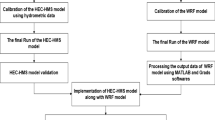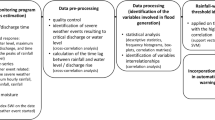Abstract
“Cévenol flash floods” are famous in the field of hydrology, because they are archetypical of flash floods that occur in populated areas, thereby causing heavy damages and casualties. As a consequence, their prediction has become a stimulating challenge to designers of mathematical models, whether physics based or machine learning based. Because current, state-of-the-art hydrological models have difficulty performing forecasts in the absence of rainfall previsions, new approaches are necessary. In the present paper, we show that an appropriate model selection methodology, applied to neural network models, provides reliable two-hour ahead flood forecasts.
Similar content being viewed by others
References
Oudin L, Hervieu F, Michel C, Perrin C, Andréassian V, Anctil F, Loumagne C (2005) Which potential evapotranspiration input for a lumped rainfall-runoff model? Part 2: toward a simple and efficient potential evapotranspiration model for rainfall-runoff modelling. J Hydrol 303:290–306
Le Lay M, Saulnier G-M (2007) Exploring the signature of climate and landscape spatial variabilities in flash flood events: case of the 8–9 September 2002 Cévennes-Vivarais catastrophic event. Geophys Res Lett 34:L13401
Bouvier C, Ayral P-A, Brunet P, Crespy A, Marchandise A Martin C (2006) Recent advances in rainfall-runoff modelling: extrapolation to extreme floods in Southern France. In: International workshop on hydrological extremes. Observing and modelling exceptional floods and rainfalls rende (CS), 3–4 May 2006
Estupina-Borrell V, Chorda J, Dartus D (2005) Flash-flood anticipation. CR Geosci 337:1109–1119
Bouttier F (2003) The Arome mesoscale project. In: Proceedings of the ECMWF, September 2003
Delrieu G, Ducrocq V, Gaume E, Nicol J, Payrastre O, Yates E, Kirstetter P, Andrieu H, Ayral P, Bouvier C, Creutin J, Livet M, Anquetin S, Lang M, Neppel L, Obled C, Parent-du-Chatelet J, Saulnier G-M, Walpersdorf A, Wobrock W (2004) The catastrophic flash-flood of 8–9 September 2002 in the Gard region, France: a first case study for the Cévennes-Vivarais Mediterranean Hydrometeorological Observatory. J Hydrometeorol 6:34–52
Gaume E, Livet M, Desbordes M, Villeneuve J-P (2004) Hydrological analysis of the river Aude, France, flash flood on 12 and 13 November 1999. J Hydrol 286:135–154
Sauvagnargues-Lesage S, Ayral P-A (2007) Using GIS for emergency management—a case study during the 2002 and 2003 South East flooding in France. Int J Emerg Manag 4(4):682–703
Piotrowski A, Napiorkowski J-J, Rowinski P-M (2006) Flash flood forecasting by means of neural networks and nearest neighbour approach—a comparative study. Nonlinear Process Geophys 13:443–448
Coulibaly P, Anctil F, Rasmussen P, Bobée B (2000) A recurrent neural networks approach using indices of low frequency climatic variability to forecast regional annual runoff. Hydrol Process 14:2755–2777
Coulibaly P, Anctil F, Bobée B (2000) Daily reservoir inflow forecasting using artificial neural networks with stopped training approach. J Hydrol 230:244–257
Sahoo G-B, Ray C (2006) Flow forecasting for a Hawaii stream using rating curves and neural networks. J Hydrol 317:63–80
Sahoo GB, Ray C, de Carlo E-H (2006) Use of neural networks to predict flash flood and attendant water qualities of a mountainous stream on Oahu, Hawaii. J Hydrol 327:525–538
Schmitz G-H, Cullmann J (2008) PAI-OFF: a new proposal for online flood forecasting in flash flood prone catchments. J Hydrol 360:1–14
Giustolisi O, Laucelli D (2005) Improving generalization of artificial neural networks in rainfall-runoff modelling. Hydrol Sci J 50:439–457
Nerrand O, Urbani D, Roussel-Ragot P, Personnaz L, Dreyfus G (1994) Training recurrent neural networks: why and how? An illustration in process modeling. IEEE Trans Neural Netw 5:178–184
Noilhan J, Mahfouf J-F (1996) The ISBA land surface parameterisation scheme. Glob Planet Change 13:145–159
Dreyfus G (2005) Neural networks, methodology and applications. Springer, Berlin
Kitadinis P-K, Bras R-L (1980) Real-time forecasting with a conceptual hydrologic model: 2 applications and results. Water Resour Res 16:1034–1044
Qu H-n, Oussar Y, Dreyfus G, W Xu (2009) Regularized recurrent least squares support vector machines. In: International joint conference on bioinformatics, systems biology and intelligent computing, Shanghai
Author information
Authors and Affiliations
Corresponding author
Rights and permissions
About this article
Cite this article
Toukourou, M., Johannet, A., Dreyfus, G. et al. Rainfall-runoff modeling of flash floods in the absence of rainfall forecasts: the case of “Cévenol flash floods”. Appl Intell 35, 178–189 (2011). https://doi.org/10.1007/s10489-010-0210-y
Published:
Issue Date:
DOI: https://doi.org/10.1007/s10489-010-0210-y




